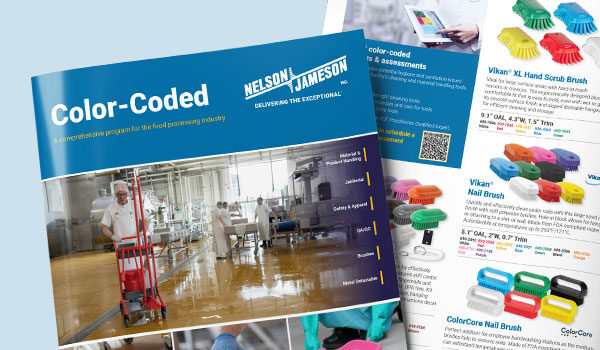
Problem: Not enough people are involved in the planning process.
Solution: Involve your management team, purchasing agents, and line workers from the very beginning. With everyone involved, you ensure buy-in from the start and better execution.
Problem: Decisions are made too quickly.
Solution: Your color coding should be planned carefully, taking into account the specific requirements of your facility, processes, and people – as well as auditor requirements. Adjust your plan as you work to ensure it fits the unique needs of your plant.
Problem: No company-wide training schedule.
Solution: It is important that you ensure your team – at all levels of your organization – receives the training necessary to carry out your plan correctly. Organize training early so your employees know how to work with color coding from the start.
Problem: The color-coding system is too complex.
Solution: A color-coding system works best when it is as simple as possible. Restrict your color-coding plan to as few colors as makes sense. Keeping it simple helps everyone understand the plan – and stick to it.
Problem: The colors chosen do not provide sufficient contrast with the food products.
Solution: Select colors that contrast clearly with the food in order to ensure that any foreign bodies (bristles or plastic fragments) are more easily seen, resulting in increased food safety.
Problem: Purchasers choose the cheapest options.
Solution: Sometimes the cheapest option will work – but a low initial investment often leads to higher long-term costs because the equipment needs to be replaced more frequently and can increase the risk of food product contamination. Ensure your
purchasing agents understand the long-term requirements and the food safety and quality
implications so they make the best choice possible from the start.
Problem: Everyone is too focused on the big picture.
Solution: It is important to keep the big picture in mind, but your solution must be practical. When designing your plan and selecting equipment, make sure to ask detailed questions. Will the tool work in practice? Is it durable enough? Is it hygienically designed? Is it food-contact compliant and accompanied by the appropriate documentation? Is it easy to store?

Vikan is a leading supplier of hygienic cleaning tools and insight for the food & beverage industry and other hygiene-sensitive environments in North America.

December 10, 2025
What is OSHA's Regional Emphasis Program (REP) for the food manufacturing industry? The OSHA Regional Em...

December 8, 2025
There is a fundamental connection between worker safety and food safety: A failure in worker safety can ...

December 1, 2025
Nelson-Jameson understands that efficiency and worker safety are equally important goals in food manufac...

Recognize and address possible hygiene and sanitation challenges based on the cleaning and material handling equipment available in your facility.
Through a discovery call, virtual, or on-site assessment, Vikan SQF Practitioner certified specialists will assist in confirming that your system and cleaning tool inventory aligns with your risk management objectives while pinpointing any missing tools and enhancing maintenance and usage practices. Evaluate whether your existing tools are utilized in the most effective manner, or determine if a more suitable tool exists for the task at hand. Ensure that your tools comply with all relevant standards and regulatory requirements. Site evaluations encompass a summary survey, an overview of the location, a color-coded factory layout plan, product suggestions, a recommended order form, and a proposal for a follow-up survey.
Food Safety, Sanitation, Cleaning Tools, Color Coding

This is a comprehensive program for the food processing industry. Nelson-Jameson brings together the most extensive collection of color-coded products for material handling, product handling, janitorial, safety, apparel, QA/QC, and metal-detectable applications. With the right pieces, a color-coding system is a powerful tool in preventing cross-contamination of allergens and food-borne illnesses that can lead to sickness or expensive product recalls.

Food Safety, Sanitation, Cleaning Tools, Color Coding

With existing and emerging threats, food safety has never been more important to food manufacturers in protecting their consumers and their organization.
Color Coding

Laboratory, Color Coding, Food Safety